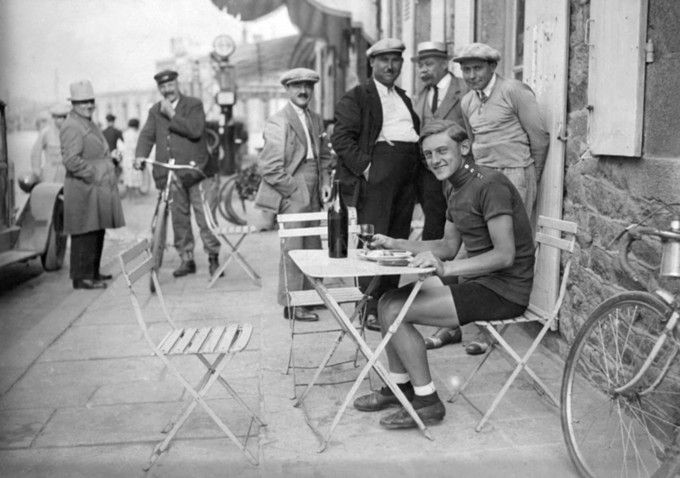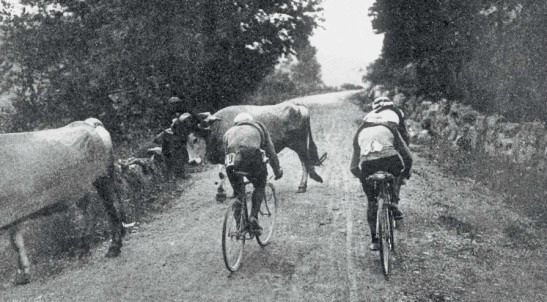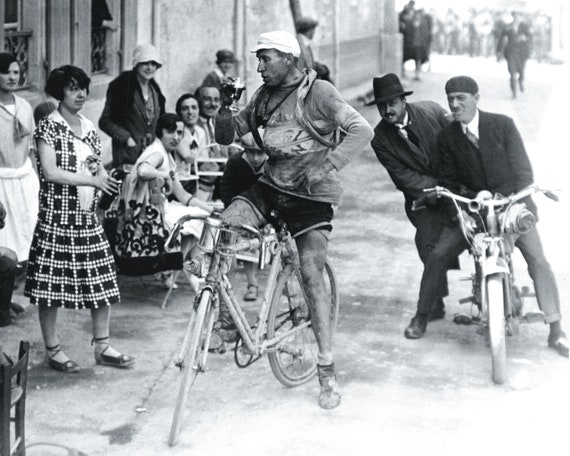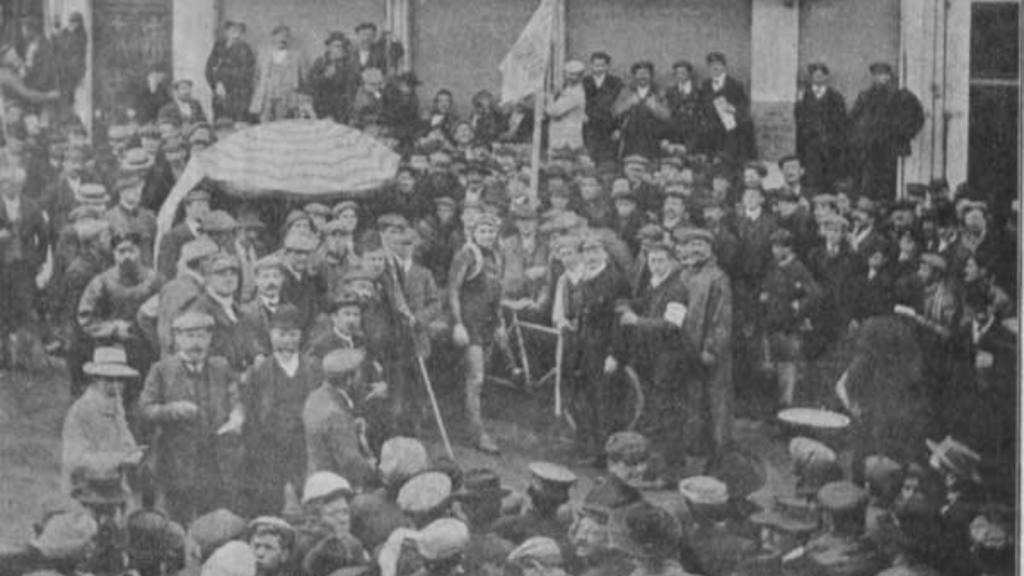Probably most of the readers of this post have seen short videos from the early years of the 1900s. For example, about a crowd gathering at an outdoor event, where both children and adults are curious about the new technology and looking right into the camera. Women in long dresses and big hats are getting off the train at a busy railway station. Young couples, a rather larger circle of friends, are sitting at a table in the garden of a big café. They’re behaving a bit burlesque-ish, everyone is moving slightly quicker than it’s natural. On the other hand, their grotesque gestures emphasize our illusiouric perception of “past is a foreign country”, and this seemingly joyfull silent chaos also make us feel that the past might have been a better place.
In the early days of Tour de France, when the concept of a multiple-stage race was new, cafés and taverns were the obvious meeting points. They served as checkpoints and refreshment places for cyclists, also spectators had the opportunity to consum while waiting for the arriving riders.
Reading about the early years of Tour de France for me is also imaging scenes at these places in those styles of more than hundred years old videos. The illusion of excitement evoked by the strange gestures of the people on the film. Excitement about everything new born at the turn of the 19th and 20th century.

And even among these new things, road cycling evets had (and in a way still have) a cenry unique attribute. Unlike other sports where the spectators had to go to the special places built with the purpose to be a home of certain sport events,
road cycling visited the public places of the everyday life.

When the practical part of organizing Tour de France, the first multipe stage road cycling event, started, cafés and taverns in smaller towns and came handy. After all, there must have been some checkpoints, also kind of feed zones during the long-long stages. Feed zones like we know them nowadays weren’t organized by the race officials. Some of the bigger stars had their own crew waiting for them with prepared meal at the checkpoint, but many of the participants had to figure out themselves how to get some food.
Still remember the situation I described earlier about the social gathering with quickly gesturing, busy and excited looking people?
Now imagine these people in a very crowded café that serves as a checkpoint for a road cycling race. A new, trendy type of social event, where women want to show their new dresses (fashion magazines used to pay attention to what to wear as a spectator at a cycling race) and men wanted to show that they are in touch with modern times. Some of them might have not necessarily been interested in cycling, but they thought it’s a must-be-there event. (Nothing has changed over the last hundred or so years. When Tour de France visited Yorkshire in 2014, many people stood at the side of the roads just to check in social media to show that they are attending a cool event.)
So, our grotesque-gesticulating guests are very busy to fulfill the purpose of socializing, and they are paying little attention to the fact that the table next to them has emptied. But just a moment later (in my imagination it is a very-very crowded café, even our protagonists are sitting a bit unconfortable because the tables are too close to each other), a cyclist, who just arrived at the checkpoint is sitting next to them. He is exhausted and might be a bit disoriented, how the noise of his own bicycle he listened to hours and hours is suddenly replaced by the cacophony of a human gathering.
One of the women in the small company takes a quick look at him and turns back to the others and continues gossiping.
When I say that road cycling history is more than just the history of race results, I usually think of this scene.
I imagine it based what I’ve read about early road cycling races and how sport was always considered, even for the passive spectators, a social event. I’m kind of mesmerised by watching old videos capturing the behaviour of people lived hundred (and even more) years ago. Also, during the years creating content about the stories behind famous vintage road cycling images, I have seen so many pictures with cyclists eating in a tavern (like the very famous one with Robert Jacquinot at the Tour de France in 1922).
Cyclists and spectators are sitting next to each other in a crowded place can symbolize how close road cycling comes to the everyday life. Closer than most of the other sports.
On the other hand, when bicycle was born it was only one of many radical changes in the European society. Some might argue, that it was the most important, the most revolutionary one from all of them, but it was not the only one that helped turning upside down the life people lived at the end of the 19th century. (There was, for example, the other one I’m frequently mentioning in this post, the film camera.)

Thus in a special way it is also very important to pay attention to the people gathered at these early cycling events. Why they came, what they knew, how they felt, etc. etc.etc..
Writing about road cycling history doesn’t stop when the cyclists crosses the finish line. There are so many other aspects to consider.
That’ s why I created my Patreon page to try to depict this wider picture. Yoi can find there a longer and a slightly different version of this post too, ans some other ones.
